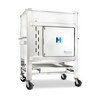QIA56 Sigma-AldrichMMP-9 ELISA Kit
Synonyms: Gelatinase B ELISA Kit, 92 kDa Gelatinase ELISA Kit, Matrix Metalloproteinase 9 ELISA Kit
Recommended Products
Přehled
| Replacement Information |
|---|
Tabulka spec. kláve
| Species Reactivity | Detection Methods |
|---|---|
| H | Colorimetric |
Products
| Katalogové číslo | Balení | ks/bal. | |
|---|---|---|---|
| QIA56-1EA | Lepenková krabice | 1 ea |
| Applications |
|---|
| Biological Information | |
|---|---|
| Assay range | 0.625 - 20 ng/ml |
| Assay time | 3.5 h |
| Sample Type | Tissue culture media, serum, plasma |
| Species Reactivity |
|
| Physicochemical Information | |
|---|---|
| Sensitivity | 0.1 ng/ml |
| Dimensions |
|---|
| Materials Information |
|---|
| Toxicological Information |
|---|
| Safety Information according to GHS |
|---|
| Product Usage Statements | |
|---|---|
| Intended use | The Calbiochem® MMP-9 ELISA Kit is a non-isotopic immunoassay for the in vitro quantitation of human MMP-9 protein in tissue culture medium, serum, and plasma. |
| Packaging Information |
|---|
| Transport Information |
|---|
| Specifications |
|---|
| Global Trade Item Number | |
|---|---|
| Katalogové číslo | GTIN |
| QIA56-1EA | 04055977209112 |
Documentation
MMP-9 ELISA Kit Certificates of Analysis
| Title | Lot Number |
|---|---|
| QIA56 |
References
| Přehled odkazů |
|---|
| Massova, I., et al. 1998. FASEB J. 12, 1075. Xie, B.,et al. 1998. J. Biol. Chem. 273, 11576. Borden, P., and Heller, R. A. 1997. Crit. Rev. Eukaryot. Gen. Expression 7, 159. Chambers, A. F., and Matrisian, L. M. 1997. J. Natl. Cancer Inst. 89, 1260. DeClerck, Y.A., et al. 1997. Adv. Exp. Med. Biol. 425, 89. Gomis-Ruth, F. X., et al. 1997. Nature 389, 77. Murphy, G., and Knauper, V. 1997. Matrix Biol. 15, 511. Olson, M. W., et al. 1997. J. Biol. Chem. 272, 29975. Woodhouse, F. C., et al. 1997. Cancer 80, 1529. Yu, A. E., et al. 1997. Drugs Aging 11, 229. Coussens, L. M., and Werb, Z. 1996. Chem. Biol. 3, 895. Lim Y.T., et al. 1996. J. Cell. Physiol. 167, 333. Kohn, E. C., and Liotta, L. A. 1995. Cancer Res. 55, 1856. Shapiro, S.D., et al. 1995. J. Biol. Chem. 270, 6351. Murphy, G., et al. 1994. J. Biol. Chem. 269, 6632. Fridman, R., et al. 1993. Biochem J. 289, 411. Goldberg, G. L., et al. 1992. J. Biol. Chem. 267, 4583. Morodomi T.,et al. 1992. Biochem. J. 285, 603. |
Brochure
| Title |
|---|
| Kit SourceBook - 2nd Edition EURO |





















